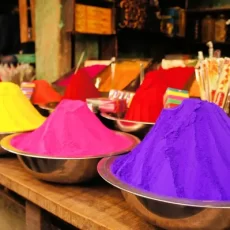Nagesh Alai
Spring is in the air, so are the hues all bright and beautiful. You just have to see the transformation of tree barren and shorn now sprouting leaves all green and flowers all colours. The passage of winter and the onset of spring see grains fill up farmers’ barns and smiles fill up their faces. Love is in the air all alive and cheerful. Little wonder all these reflect in riotous colours being sprayed and splayed with gaiety in community celebrations of Holi to herald spring across our great country. Happyho also provides best Meditation and Tarot classes in Noida and Delhi NCR India area
Of course, as in most festivals, religion, belief, custom and culture have their relevance. Lord Krishna had his role to play in the genesis of this lovely festivity. Folklore has it that Krishna, having turned blue due to poisoning of milk by the nursemaid Puttana, was advised by his mother, Yashoda to spray colours on his ladylove, Radha, so that she does not spurn the blue skinned avatar of Lord Vishnu. Little wonder, Vrindavan in the north is unmatched for the celebration of Holi. The symbolism of victory of good over evil is reflected in the Holi pyre lit to reflect Holika (sister of Hiranyakashyap, a powerful rakshasha king of yore ) getting burnt and killed while attempting to kill Prahlada ( son of Hiranyakasipu ) , an ardent bhakt of Lord Vishnu, in a pyre. Lord Shiva is also believed to have burnt Kaamadeva, the god of desire, on Holi day for disturbing him in his penance; Kaamadeva was only acting at the behest of other gods to get Shiva out of his penance and save the world from Tarakasura.
Stories aplenty, lores many why Holi is celebrated. Whether it is faith or revelry, it is celebrated with gay and gusto by the young and old. The riot of colours in the festivity is but a reflection of the colours of the spring, as it could be the fragrance of smell. Bhaang and thandai add their own flavors to the merriment.
While all of us celebrate colours in all their hues and gaiety, I wonder often why we take colours for granted in a world of ‘sightism’. Nature, however much perceived to be perfect, disproves the presumption by denying one or more of the five senses ( sight, smell, sound, touch and taste ) in very many cases. A thus-far-inability to understand nature’s shortcoming ( I would loathe to call it manufacturing defect ), has seen ‘natural selection’ as a preferred descriptor for those deprived of any of these senses. To the completely endowed of the 5 senses, a blind person is seen as imperfect or wanting or needing specialised treatment because the visually challenged do not fit into their understanding of what a perfect world is and as such missing out on the joy of colours. Talking of colours, are they a perception or a reality? Are they the effect of photosynthesis or the play of sunlight? Why is it that the white light , when passing through a prism, is seen as a spectrum of 7 colours or vibgyor? Are colours nothing but white? Or is not black too a colour of different shade?
While the blind are seen as disadvantaged by the advantaged, are we really fully advantaged? Can we see beyond the 180° periphery of our eyes or see our back or beyond. To that extent, are we not also limited in our visual capacity? For all we know, and this is really difficult to articulate, the blind may be seeing or having the capacity to visualize colours far more than what we can see.
Having said that, rather than seeing the visually impaired from a lens of pity, it may make more sense to bring about a behavioral change in ourselves to perceive the blind as being normal and differently endowed. Perhaps, each of us can go that extra mile in spending time with the blind and give them a vicarious sense ( am intentionally refraining from using the word ‘pleasure’ ) of what colour is the way we see it. For e.g., how about equating the yellow colour of say a lemon or a banana with that of the sun (which the blind can feel)? How about expressing the heat or warmth of sun as the red colour? How about equating the green colour to say grass or capsicum that have a tactile velvety and smooth feel? Or the brown colour to the dry leaves in summer. Or the ocean with blue colour and sense of cool? There are endless examples of flowers and fruits and food and all things natural which can be brought out descriptively and contextually alive.
If only we can all learn this ability and make the Holi celebrations that much more inclusive for the visually impaired, it may work wonders. Celebrate we all must, fun we must all have. But these need not be at the cost of a presumed disadvantage of the blind. Maybe the blind see far better than us due to their enhanced sense of perception and other faculties. To the blind, our colours may all be just a monochrome and far less colourful than the infinite colours they perceive. Is it not then best to accept the blind the way they are?
Perhaps, there was no need for Gandhari to have blindfolded herself just because her husband, Dhritarashtra, was born blind. Maybe Mahabharata would have taken a different course had she not turned a blind eye! Let not the sighted see the blind as blind!
Happy Holi.


